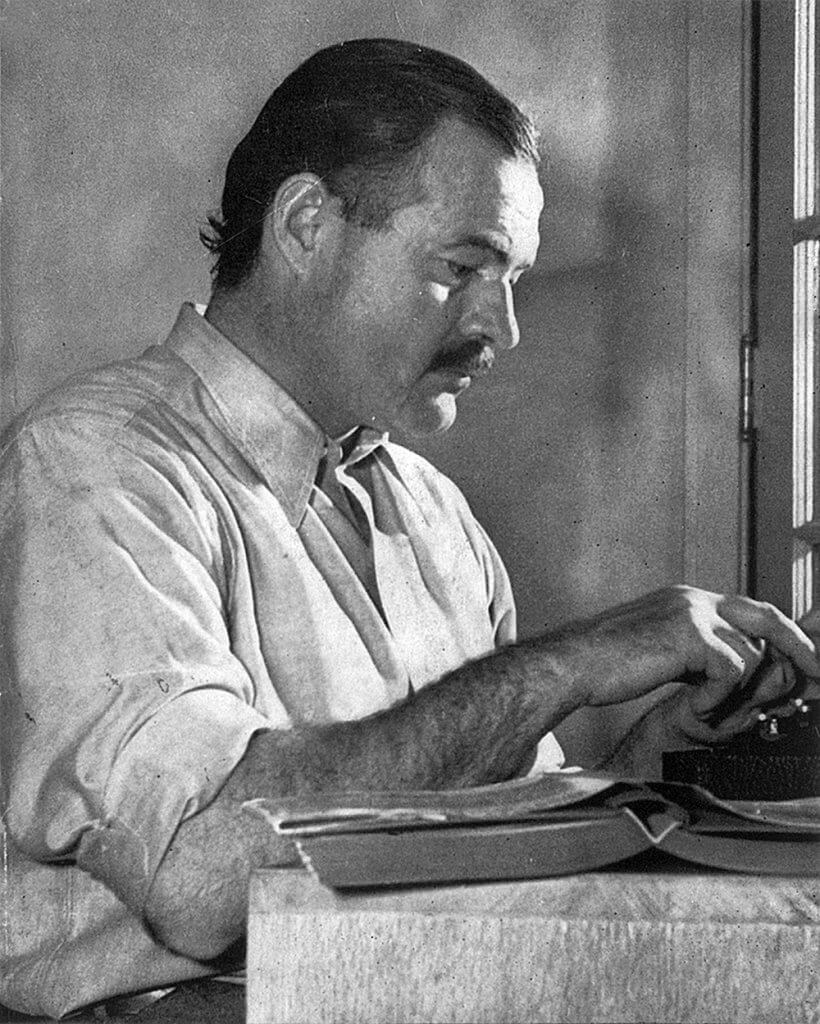From 1928 to 1946, Ernest Hemingway was a frequent visitor to Wyoming. He referred to the state as “damn lovely country,” and told Wyoming rancher Else Spear Byron, “There are two places I love—Africa and Wyoming.” This was made evident by his many stays, and by life events that cemented his relationship to Wyoming. There are many ways to connect to this beloved author while visiting Wyoming, and detours to explore that will enrich your journey.
Hemingway’s Wyoming
Sheridan
Hemingway’s initial exposure to Wyoming was propelled by his need for solace as he finished A Farewell to Arms. He started at Folly Ranch near Sheridan but found the tourist traffic to be too disruptive to his process. Moving into the third floor of the Sheridan Inn gave him more peace to formulate his prose, but it wasn’t until he landed at the Spear Family Ranch in the Bighorn Range that he was able to complete this American classic.
Buffalo
Just south of Sheridan lies the town of Buffalo, where one hotel was frequented by a host of famous individuals, including Hemingway. The Historic Occidental Hotel served as a stop for Hemingway on his way to Sheridan. Theodore Roosevelt, Owen Wister (author of The Virginian) and Calamity Jane were among well-known people who stayed at this hotel.
Shell
Immersed in the idyllic setting of the Spear Family Ranch, also called Spear-O-Wigwam, Hemingway penned the short story “Wine of Wyoming.” Written during Prohibition, the tale reveals the damage done to his psyche as a result of war. He and his fellow expatriates in Paris renounced the bourgeois, and this mindset crept into his work. The nonsensical style of “Wine of Wyoming” is a prime example of his own attempt to cope with the insanity of war.
Cody

A trip to Wyoming in 1930 took Hemingway to the region surrounding Cody. At the L Bar T Ranch, he worked on Death in the Afternoon, his fluid yet brutal treatise on the sport of bullfighting. He would later draft To Have and Have Not at this same location. Both of these works embody the violence that he witnessed during his lifetime.
Cheyenne
On a trip through Wyoming in 1940, Hemingway and journalist Martha Gelhorn disembarked from a train in Cheyenne to tie the knot. They were married by a justice of the peace at the Union Pacific Railroad Depot. A National Historic Landmark, this depot still stands. Visitors can learn about the history of the Transcontinental Railroad here, at the Cheyenne Depot Museum.
Casper
When his fourth wife Mary endured an ectopic pregnancy in 1946 in Casper, Hemingway met his sons to fish the North Platte River while she recuperated. At the Mission Motor Court in Casper, he drafted what would later become the novel Garden of Eden. At the same time, he worked on Across the River and into the Trees.
Travel Through Wyoming with Ernest Hemingway
For fans of this beloved American author, following the route between Buffalo and Sheridan will be made even more enriching with Hemingway Highways. This audio tour, narrated by the writer’s granddaughter Mariel Hemingway, takes the traveler through north-central Wyoming and unfolds over 40 miles along the winding highway from Buffalo to Big Horn to Sheridan.
Presented by the Wyoming Humanities Council, and Sheridan College with support from the National Endowment of Humanities, another route of Hemingway Highways focuses on Wyoming’s Route 14 and the stretch between Yellowstone Lake and Cody.
Exploring Hemingway in this manner educates the fan not just on the author’s love of Wyoming, but on the state itself. Iconic figures such as Butch Cassidy and Buffalo Bill Cody also called the surrounding wilderness home and left their own marks as historic legends. The true nature of Wyoming is revealed in wild wonder through the use of these audio tours.
Wyoming’s Stamp on Hemingway
Hemingway nurtured his writing in the American West, but Wyoming seemed to hold special meaning to him. He was fed by the pristine landscape and his infamous love of fly fishing and hunting. As written for Vogue in his 1939 short story, “The Clark’s Fork Valley, Wyoming”:
It was wonderful fly-fishing then in the first weeks of September. The native trout were sleek, shining, heavy and nearly all of them leaped when they took the fly. If you fished two flies, you would often have two big trout on and the need to handle them very delicately in that heavy current.
There are stories surrounding Hemingway’s penchant for bear hunting, and he did in fact take down a few during his time at L Bar T. He notoriously shot and killed a grizzly there, and as he rode victoriously from the kill site, he tumbled from his horse and shattered his knee. He recovered in the Cody hospital.
“When you shoot and fish, you have to move often, and always further out.”
Ernest Hemingway
When the life of an artist is considered, it is not just the works left behind. It is the inspiration that fed those works, and the connections that are fostered through the act of creating. For Hemingway, a man who lived large and even recklessly, he was satiated by the atmosphere and spirit of Wyoming. Still rich in beauty and dense in wilderness, this territory beckons us all.
This article was written on behalf of Travel Wyoming by Jenn Rein, New Thought Digital Agency.